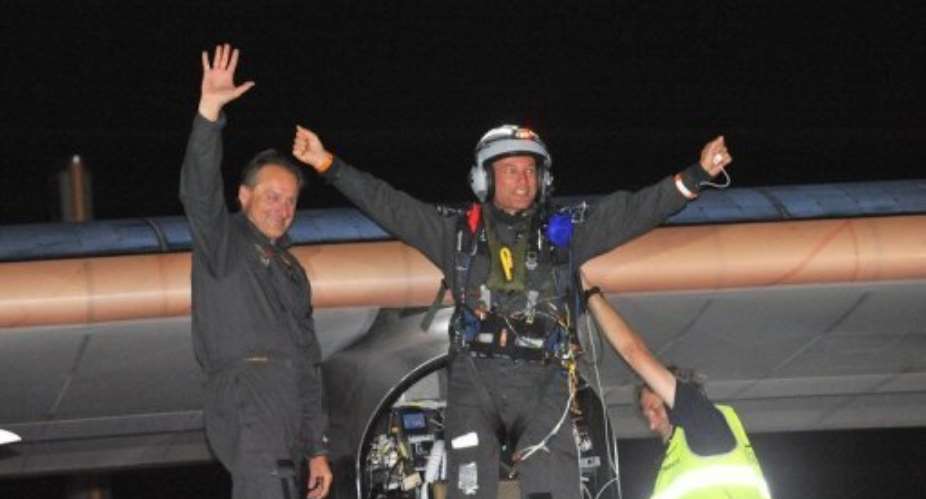RABAT (AFP) - The solar-powered plane that last week made the world's first inter-continental flight took off on its most difficult challenge yet on Wednesday, flying in Morocco's desert climate.
Swiss pilot Andre Borschberg steered the Solar Impulse plane into the skies from Rabat airport at 0707 GMT and headed south toward the city of Ourzazate where he is expected to land around 2300 GMT if all goes well.
"This flight will certainly be the most difficult the plane has ever undertaken due to the hot and dry nature of the climate as well as the proximity of the massive Atlas mountains," towering up to more than 3,000 metres (9,800 feet), said a statement released by organisers on Tuesday.
"It is potentially extremely dangerous," said pilot Borschberg. "I know it is not going to be easy but I have the deep feeling that we know enough" to make a successful landing in the desert.
The high-tech aircraft, which has the wingspan of a large airliner but weighs no more than a medium-sized car, is fitted with 12,000 solar cells feeding four electric engines and flies without using a drop of fuel.
Last week it flew into history books as it completed the world's first inter-continental flight by a solar plane, flying from Spain to Morocco, a feat that capped a string of other firsts, including the first manned plane to fly around the clock on sun's energy in July 2010.
It holds the record for the longest flight by a manned solar-powered plane after staying aloft for 26 hours, 10 minutes and 19 seconds above Switzerland, and has also set a record for altitude by flying at 9,235 metres (30,298 feet).
Flying above the Moroccan sand dunes -- the backdrop to the 1962 British cinema epic "Lawrence of Arabia" -- poses particular challenges such as thermal currents, strong winds and thunderstorms.
In fact, weather conditions could prompt the flight director to delay the flight or alter the route.
Two itineraries for Wednesday's flight are under consideration: one would follow Morocco's Altantic coastline to Agadir at an altitude of 8,600 metres (28,000 feet) and bypass the Atlas mountains, while an inland option would take the aircraft towards Marrakesh at the foot of Atlas range.
The flight will be live-streamed on the project's website www.solarimpulse.com.
Last month, the solar-powered aircraft made the 2,500-kilometre (1,550-mile) journey from Madrid to Rabat, its longest to date, after an inaugural flight to Paris and Brussels last year.
The flights are intended as a rehearsal for the goal of a round-the-world trip in 2014.
The southern Moroccan destination of Quarzazate is also the future site of Morocco's first solar energy complex, the solar energy agency Masen said in a joint statement with Solar Impulse.
Masen is in charge of building the 160 megawatt solar energy plant with plans to reach a capacity of 500 MW by 2015.





 This IMANI job no dey pap; the people you are fighting for are always fighting y...
This IMANI job no dey pap; the people you are fighting for are always fighting y...
 Prof. Naana Opoku-Agyemang has changed; you can see a certain sense of urgency –...
Prof. Naana Opoku-Agyemang has changed; you can see a certain sense of urgency –...
 MFWA Executive Director slams Akoma FM for engaging in ‘irresponsible’ media pra...
MFWA Executive Director slams Akoma FM for engaging in ‘irresponsible’ media pra...
 ‘Women must become millionaires too’ — Prof Jane Naana on establishment of Women...
‘Women must become millionaires too’ — Prof Jane Naana on establishment of Women...
 Some believe only in Ghanaian votes, not Ghana — Kofi Asare jabs politicians
Some believe only in Ghanaian votes, not Ghana — Kofi Asare jabs politicians
 Plan to make BEST sole aggregator of Sentuo Oil Refinery will create market chal...
Plan to make BEST sole aggregator of Sentuo Oil Refinery will create market chal...
 2024 elections: I can't have the man I removed from office as my successor — Aku...
2024 elections: I can't have the man I removed from office as my successor — Aku...
 2024 Elections: Immediate-past NPP Germany Branch Chairman garners massive votes...
2024 Elections: Immediate-past NPP Germany Branch Chairman garners massive votes...
 Gov’t focused on making Ghana energy self-sufficient, eco-friendly – Akufo-Addo
Gov’t focused on making Ghana energy self-sufficient, eco-friendly – Akufo-Addo
 April 25: Cedi sells at GHS13.74 to $1, GHS13.14 on BoG interbank
April 25: Cedi sells at GHS13.74 to $1, GHS13.14 on BoG interbank
